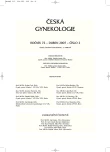-
Medical journals
- Career
Contribution of Neoadjuvant Chemotherapy for Operability of Cancers of the Uterine Cervix
Authors: J. Sláma; D. Cibula; P. Freitag; D. Fischerová; M. Janoušek; D. Pavlišta; M. Strunová; Michal Zikán; N. Jančárková
Authors‘ workplace: Gynekologicko-porodnická klinika VFN a 1. LF UK, Praha, přednosta prof. MUDr. A. Martan, DrSc.
Published in: Ceska Gynekol 2007; 72(2): 116-119
Category: Original Article
Overview
Objective:
To compare per-operative and post-operative morbidity in patients undergoing radical surgery for carcinoma of the uterine cervix after administration of a neoadjuvant chemotherapy, and for primarily small cervical tumour.Type of the study:
A retrospective case-control study.Setting:
Department of Obstetrics and Gyneacology, 1st Faculty of Medicine, Charles University and General Teaching Hospital, Prague.Methods:
The study included 24 patients with squamous cell carcinoma of the uterine cervix who underwent radical hysterectomy including systematic pelvic lymphadenectomy after previous administration of neoadjuvant chemotherapy (NACT) during the period between 1/2004 and 6/2006. The control group of 24 patients was selected retrospectively from the population of women after radical surgery carried out in the same period, nevertheless, the controls underwent the surgery for primarily small carcinoma of the uterine cervix, stages IA2 or IB1. The tumour size consistent with the reduced tumour after NACT administration was the criterion for selection of the control group. The following parameters were monitored in both groups – duration of the surgery, blood loss objectivised by a difference in pre-operative and post-operative haemoglobin and haematocrit values, the need of blood transfusion, per-operative complications, early post-operative complications (up to 6 weeks after the surgery), duration of hospitalization and retaining the inserted epicystotostomy due to hypotonic bladder after discharge.Results:
A therapeutic response allowing the radical surgery was achieved in 92% patients after NACT. After NACT the original tumour volume was reduced by 70% on the average (58% – 100%). No significant differences between the group of patients treated with NACT and undergoing subsequent radical hysterectomy and the control group were reported in terms of duration of the surgery (165 min. vs. 160 min.), blood loss (the difference in pre-operative and post-operative haemoglobin values 18 g/l vs. 19 g/l, the difference in pre-operative and post-operative haematocrit values 0.056 vs. 0.064), administration of blood transfusion (25% vs. 21%) and duration of hospitalization (9.5 days vs. 9.6 days). A significant difference was reported only in the need to retain the inserted epi-cystostomy after discharge (67% vs. 47%).Conclusion:
There were no significant differences in the evaluated parameters of per-operative and postoperative morbidity in patients after NACT and in control patients, except for the necessary duration of artificial urine derivation in patients after NACT due to the fact that their surgery was more radical in the parametria. Administration of NACT regimen involving ifosfamide / cisplatin (IP) improved surgical conditions in the bulky squamous cell carcinoma of the uterine cervix.Key words:
cervical carcinoma, neoadjuvant chemotherapy, radical hysterectomy
Labels
Paediatric gynaecology Gynaecology and obstetrics Reproduction medicine
Article was published inCzech Gynaecology

2007 Issue 2-
All articles in this issue
- Is there an Increasing Frequency of Long-term Perinatal Morbidity with Decreasing Perinatal Mortality or Is it also Declining
- Biochemical Parameters of the Intrahepatic Cholestasis of Pregnancy
- Intrahepatic Cholestasis in Pregnancy – Guidelines of Treatment
- Evaluation of psychophysical mood after family and traditional delivery
- Birth Defects in the Czech Republic in the Period 1994 - 2005 – Perinatology Data
- Evaluation of the Development of Laparoscopically-Assisted Vaginal Hysterectomy in the Czech Republic over the Last 10 Years Based on the Data of the National Registry of Gynecology Laparoscopy Complications
- Transforming Growth Factor - beta 1 as a Marker in Patients with Operable Breast Cancer
- Contribution of Neoadjuvant Chemotherapy for Operability of Cancers of the Uterine Cervix
- Detekce sentinelové uzliny u časných stadií cervikálního karcinomu kombinovanou metodou s užitím nanokoloidu technecia Tc99 a patentní modři
- Extended Field Radiotherapy and High–Dose Brachytherapy Combined with Chemotherapy in Patients with Locally Advanced Cervical Carcinoma
- Synechia Vulvae Infantum – Incidence on Department of Obstetric/Gynaecology, Teaching Hospital Na Bulovce, the First Medical Faculty of Charles University in Prague, Czech Republic from 2001 through 2005
- Rare Tumours of Myometrium – Intravenous Leiomyomatosis and Benign Metastatic Leiomyoma
- Acute Fatty Liver of Pregnancy (AFLP) – Case Report
- Late (Non-classic) Adrenal Hyperplasia
- Czech Gynaecology
- Journal archive
- Current issue
- Online only
- About the journal
Most read in this issue- Acute Fatty Liver of Pregnancy (AFLP) – Case Report
- Late (Non-classic) Adrenal Hyperplasia
- Biochemical Parameters of the Intrahepatic Cholestasis of Pregnancy
- Intrahepatic Cholestasis in Pregnancy – Guidelines of Treatment
Login#ADS_BOTTOM_SCRIPTS#Forgotten passwordEnter the email address that you registered with. We will send you instructions on how to set a new password.
- Career

